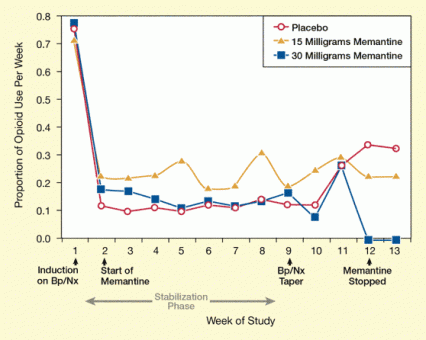Dr. Gerardo Gonzalez of the University of Massachusetts Medical School, Worcester, and colleagues were prompted to develop the regimen by concerns about the practicality and safety of treating young adults with buprenorphine. Although Bp/Nx is a widely used and highly effective treatment for opioid addiction, many young adults require repeated or long-term treatment to avoid relapse. However, young people in particular tend to prefer time-limited over indefinite treatment, and some researchers and clinicians worry that extensive exposure to buprenorphine might have deleterious effects on the still-developing adolescent brain.
Researchers have successfully pilot-tested a dual regimen that they hope will enable young adults addicted to opioids establish lasting abstinence with a relatively brief course of medication-assisted therapy. The regimen pairs the glutamate receptor antagonist memantine (Namenda) with the opioid/antagonist buprenorphine-naloxone (Bp/Nx; Suboxone). Trial participants who received it were more likely to remain abstinent than others who received Bp/Nx alone for a month following a 9-week Bp/Nx stabilization and taper protocol.
Bp/Nx and memantine both reduce cravings for opioids and symptoms of opioid withdrawal, which are major causes of relapse, especially early in recovery. They do so by different mechanisms, however—Bp/Nx through direct action at mu opioid receptors in the brain, and memantine through both direct action at glutamate receptors and indirect action at mu opioid receptors. Dr. Gonzalez and colleagues hypothesized that the two medications might therefore reinforce rather than interfere with each other’s beneficial effects, and thereby improve treatment outcomes.
In the pilot trial, 80 outpatients, ages 18 to 25, received Bp/Nx stabilization together with either memantine 30 milligrams per day, memantine 15 milligrams per day, or placebo. The Bp/Nx treatment continued for 8 weeks and was tapered off in week 9; memantine or placebo was started at the beginning of the second week of Bp/Nx and tapered off 4 weeks after Bp/Nx was discontinued. All study participants also received weekly group counseling.
 Figure. Combination Treatment With Memantine and Bp/Nx Shows Promise All three patient groups sharply reduced their opioid use after 1 week of Bp/Nx treatment and used opioids with similar frequencies while on Bp/Nx plus memantine. After Bp/Nx was discontinued, patients in the memantine 30 mg/d group reduced their opioid use to zero; patients in the memantine15 mg/d group increased their opioid use to roughly 20 percent of days; and those in the placebo group increased their opioid use to roughly 30 percent of days.
Figure. Combination Treatment With Memantine and Bp/Nx Shows Promise All three patient groups sharply reduced their opioid use after 1 week of Bp/Nx treatment and used opioids with similar frequencies while on Bp/Nx plus memantine. After Bp/Nx was discontinued, patients in the memantine 30 mg/d group reduced their opioid use to zero; patients in the memantine15 mg/d group increased their opioid use to roughly 20 percent of days; and those in the placebo group increased their opioid use to roughly 30 percent of days.(Text Description of graphic below)
The three treatment groups’ frequencies of opioid use differed slightly while they received Bp/Nx and markedly after Bp/Nx discontinuation. All three groups sharply reduced their opioid use from the week before starting treatment, when they averaged 6 to 7 days of use per week, to the last week of Bp/Nx, when they averaged 1 to 2 days of use (see Figure). During the next 4 weeks, however, the participants receiving memantine at 30 milligrams per day further reduced their use to zero, while those in the other two groups increased their use to 3 to 4 days per week. The patients in the higher-dose memantine group also reported milder withdrawal symptoms than the other two groups during the last month of the trial.
Dr. Gonzalez says that these results warrant larger trials of combination treatment with Bp/Nx and memantine. The researchers note that some of the results of the pilot trial suggest that modifying the regimen might strengthen it. In particular, dropout rates were high: half of the participants quit after Bp/Nx was discontinued, and only a quarter completed their treatments. To improve patient retention, the researchers propose extending the duration of the Bp/Nx stabilization and taper, increasing the frequency of urine testing for opioids, and adding a monetary incentive to the treatment.
This study was supported by NIH grant DA027138.
- Text Description of graphic
-
The figure shows a line graph comparing weekly opioid use in patients receiving Bp/Nx and divided into three treatment groups: 15 milligram per day memantine, 30 milligram per day memantine, or placebo. The vertical (y)-axis shows opioid use (expressed as proportion of opioid use per week on a scale from 0 to 1). The horizontal (x)-axis shows the times and phases of the treatments over the 13-week study period; as shown by arrows on this axis, Bp/Nx treatment was initiated on week 1, memantine or placebo treatment on week 2, and Bp/Nx treatment was tapered during week 9 and memantine treatment stopped on week 12. In all three groups, weekly opioid use dropped from >0.7 at week 1 to about 0.1 to 0.2 at week 2; these levels of use remained largely the same until week 10, with the 15-milligram memantine group exhibiting slightly higher weekly use (equal to or more than 0.2) than the 30-milligram memantine and placebo groups (about 0.1). On week 11, weekly opioid use rose to just under 0.3 in all three groups, followed by a drop to 0.0 among those in the 30-milligram memantine group and use of 0.2 and 0.3 in the 15-milligram memantine and placebo groups, respectively, on weeks 12 and 13.
Source:
Gonzalez, G.; DiGirolamo, G.; Romero-Gonzalez, M. et al. Memantine improves buprenorphine/naloxone treatment for opioid dependent young adults. Drug and Alcohol Dependence 156:243-253, 2015. Abstract

